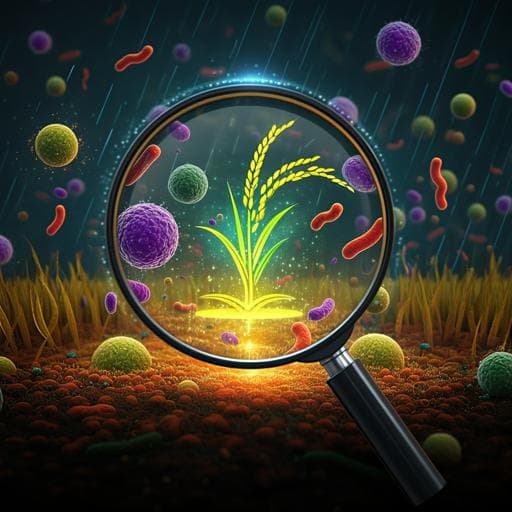
Agriculture
Microbiome variation correlates with the insecticide susceptibility in different geographic strains of a significant agricultural pest, *Nilaparvata lugens*
Y. Zhang, T. Cai, et al.
This intriguing study by Yunhua Zhang, Tingwei Cai, Maojun Yuan, Zhao Li, Ruoheng Jin, Zhijie Ren, Yao Qin, Chang Yu, Yongfeng Cai, Runhang Shu, Shun He, Jianhong Li, Adam C. N. Wong, and Hu Wan explores the relationship between microbiome composition and insecticide resistance in brown planthopper strains. The research uncovers how environmental factors influence microbial symbionts, opening avenues for innovative resistance management strategies.
~3 min • Beginner • English
Introduction
Microbes and their communities are shaped by environmental abiotic and biotic factors (e.g., geography, pH, temperature, precipitation, nutrients) and host genotype. Such variation can affect animal phenotypes, including in insects, where microbiome-environment interactions have been linked to traits such as insecticide resistance. Nilaparvata lugens (brown planthopper) is a major rice pest with widespread resistance to multiple insecticides that varies geographically due to differing exposures during annual migrations. Resistance in N. lugens is associated with expression of cytochrome P450 genes, notably NICYP6ER1, and other detoxification genes (NICYP6AY1, NICYP4CE1, NICYP6CW1). Symbionts can modulate resistance by regulating host detox gene expression, suggesting that microbiome differences could underlie susceptibility variation. While insecticide exposure is a known driver of resistance evolution, other environmental factors are underexplored. This study asks: (1) Do host genetics or microbiome variations correlate with differential insecticide responses? (2) Can specific abiotic environmental factors predict microbiome variation patterns? The authors analyze nine field strains and two laboratory strains for microbiome composition, host transcriptomes, and susceptibility to 11 insecticides, and relate these to environmental parameters, to identify correlational patterns linking environment, microbiome, detox gene expression, and resistance phenotypes.
Literature Review
The paper situates its work within evidence that environmental factors shape microbiomes and that microbiome composition influences insect phenotypes, including insecticide resistance. Prior research has shown temperature-dependent microbiome changes affecting resistance; N. lugens resistance involves P450s (e.g., NICYP6ER1) and other detox genes. Symbionts such as Wolbachia and Arsenophonus can modulate host detox gene expression and resistance levels. Environmental drivers beyond insecticide exposure (e.g., temperature, humidity) can affect symbioses and resistance, but their roles remain underexplored. The study builds on reports of geographic variation in N. lugens resistance and the potential for microbial transmission in the field to disseminate resistance-associated microbiomes.
Methodology
Study organisms: Nine field strains (FS) of N. lugens were collected from rice paddy fields across nine locations in six Chinese provinces in 2019; two laboratory strains (LS1: Wuhan 2008; LS2: originally Hangzhou 1995) maintained >10 years without insecticide exposure. All strains were reared on TN1 rice at 27±1°C, 70–80% RH, 16:8 L:D.
Insecticide bioassays: Rice-seedling dip method using 11 insecticides (imidacloprid, nitenpyram, dinotefuran, thiamethoxam, clothianidin, sulfoxaflor, isoprocarb, chlorpyrifos, buprofezin, etofenprox, and commercial triflumezopyrim). Stock solutions in DMF or water were serially diluted with 0.1% Triton X-100 or water. Fifteen seedlings per concentration were dipped 30 s and placed in cups; three replicate cups per concentration; 15 third-instar nymphs (F1/F2 of FS) per cup. Mortality recorded at 96 h (neonicotinoids and sulfoxaflor), 72 h (etofenprox, isoprocarb, chlorpyrifos), and 120 h (triflumezopyrim, buprofezin). LC50 values estimated with Polo Plus.
Sampling for sequencing: For each of the 11 strains, 30 surface-disinfected third-instar nymphs were pooled to generate 3–5 biological replicates per strain. FS were propagated 1–2 generations to obtain sufficient individuals; sequencing and bioassays used the same generation (F1/F2) for consistency.
Transcriptomics: Total RNA (3 µg) per library prepared with TruSeq RNA Sample Preparation Kit and sequenced on Illumina HiSeq. Clean reads (trim adapters, poly-N, Q<20 filtered). Gene expression quantified with RSEM; transcripts mapped to N. lugens reference genome (SAMN13382557) and annotated to KEGG Orthology via KAAS.
Microbiome profiling: Total RNA (to capture transcriptionally active microbiota) extracted with RNAiso Plus; cDNA synthesized (Hifair 1st Strand cDNA Synthesis). Amplicons: bacterial 16S rRNA V3–V4 (338F-806R) and fungal ITS1 (gITS7-ITS4) with sample-specific 7-bp barcodes. PCR products purified and quantified; Illumina NovaSeq 2×250 bp. QIIME2 2020.11 pipeline: demux, cutadapt for primer trimming, DADA2 for denoising/merging/chimera removal; non-singleton ASVs aligned with MAFFT; alpha and beta diversity analyses on rarefied data. Taxonomy assigned with classify-sklearn against SILVA 138 (bacteria) and Warcup (fungi).
Genetic background: Genomic DNA from 20 third-instar nymphs per strain; ISSR markers used to build a binary presence/absence matrix; Nei unbiased genetic distance computed with POPGENE v1.31.
Statistics and network analyses: Bray–Curtis dissimilarity matrices and PCoA computed with vegan v2.5-7; PERMANOVA (adonis) for beta-diversity differences. Spearman correlations among LC50 values, transcript abundances, and microbial taxa performed with corAndPvalue (WGCNA v1.69), FDR-corrected (Benjamini–Hochberg), with adjusted P<0.05 threshold. Networks visualized in Gephi v0.9.2. Environmental data (daily average temperature and precipitation, July–September) sourced from China Meteorological Administration; geographic coordinates used to compute distances. Distance–decay relationships assessed by linear regression between geographic distance and community similarity; Mantel tests (Pearson, 999 permutations) to assess contributions of genetic background to microbiome composition. Data visualization in GraphPad Prism 7.0 and R.
Key Findings
- Susceptibility variation: LC50-based susceptibilities to 11 insecticides varied substantially among nine field strains and two lab strains. Clothianidin showed the highest inter-strain variability; triflumezopyrim the lowest. Neonicotinoids, buprofezin, and isoprocarb exhibited greater inter-strain variation than other insecticides.
- Separation of profiles: PCoA of susceptibility profiles separated lab strains from field strains along PCOA1; eight of nine field strains clustered, with HNCS as an outlier (PERMANOVA r=0.557, P=0.021).
- Cross-resistance: Positive Spearman correlations among LC50s were observed for insecticides targeting nicotinic acetylcholine receptors. Imidacloprid LC50 correlated positively with thiamethoxam, dinotefuran, sulfoxaflor, and triflumezopyrim (P<0.05), indicating shared resistance mechanisms.
- Transcriptome associations: Significant transcriptomic differences among 11 strains (PERMANOVA r=0.445, P=0.006), but not between FS vs LS (r=0.037, P=0.266). Dense correlation networks linked insecticide susceptibilities to host gene expression. Across insecticides, 926 genes (35.67%) were shared among susceptibility-associated transcripts. Imidacloprid had 666 associated genes, mostly negative correlations (468; 70.27%).
- Detoxification genes: 41 detox genes (18 P450, 3 GST, 20 EST) correlated with at least one insecticide. CYP6ER1 transcripts showed positive correlations with LC50 for seven insecticides (imidacloprid, nitenpyram, dinotefuran, clothianidin, triflumezopyrim, buprofezin, isoprocarb).
- Microbiome composition: 372 bacterial and 1732 fungal taxa identified. Dominant bacteria: Wolbachia, Arsenophonus, Acinetobacter_rhizosphaerae, Staphylococcus_sciuri (>80% of reads); fungal communities dominated by Hirsutella. Beta-diversity differed among strains (bacteria PERMANOVA r=0.423, P=0.001; fungi r=0.475, P=0.001) and between FS and LS (bacteria r=0.055, P=0.015; fungi r=0.12, P=0.001).
- Microbe–gene correlations: Among core taxa (33 bacterial, 11 fungal genera), detox genes correlated with bacterial but not fungal abundances: 7 P450, 2 GST, 3 EST linked to specific bacteria. Five NICYP6ER1 variants (Nlug21310, Nlug25418, Nlug25673, Nlug25674, Nlug27339) correlated with six bacterial genera. NICYP6AX1 showed a strong negative correlation with Arsenophonus abundance.
- Environment–microbiome links: Core microbiome diversity weakly related to host genetic background (Mantel P≈0.051–0.053). Fungal observed ASVs correlated with temperature (P=0.037) and longitude (P=0.0052); bacterial alpha-diversity indices showed no significant such correlations. Distance–decay was significant for fungi (slope −0.034, R2=0.16, P<0.0001) but not for bacteria (slope −0.0061, R2=0.0017, P=0.1215). Abundances of several core taxa correlated with precipitation, temperature and/or latitude, including bacterial Hydrocarboniphaga (precipitation r≈0.73) and Comamonadaceae (precipitation r≈0.71), which were also linked to detox gene expression.
- Overall pattern: Environmental abiotic factors better predicted microbiome variation than host genotype; microbiome–detox gene associations tracked insecticide susceptibility across field strains.
Discussion
The study addresses whether microbiome or host genetics better explain geographic variability in N. lugens insecticide susceptibility. Results indicate that susceptibility profiles correlate with host detox gene expression, particularly CYP6ER1 variants, and that these detox genes associate with specific bacterial symbiont abundances. Environmental factors (temperature, precipitation, location) correlate with core microbiome composition, especially fungi, and with the abundances of certain bacteria linked to detox gene expression. Host genetic background showed only weak associations with microbiome structure. Together, these patterns support a model where abiotic environment shapes the microbiome, which in turn modulates host detoxification gene expression, influencing susceptibility to multiple insecticides. Cross-resistance among nicotinic receptor-targeting insecticides aligns with shared detoxification pathways. The concept of an “insecticide-resistant microbiome” emerges, wherein the presence/abundance of certain taxa could predict resistance phenotypes. Potential horizontal transmission of key symbionts (e.g., Arsenophonus) may facilitate field dissemination of resistance-associated microbiomes, helping explain persistent resistance despite discontinued insecticide use.
Conclusion
This work demonstrates that microbiome variation among geographic strains of N. lugens correlates with differences in insecticide susceptibility via associations with host detoxification gene expression, notably CYP6ER1. Environmental abiotic factors are stronger predictors of microbiome variation than host genotype, suggesting an environment–microbiome–host axis underlying resistance phenotypes. These insights can inform microbial-based strategies for resistance management and the use of detox gene and microbial markers for surveillance. Future studies should establish causality through manipulation experiments, assess the role of specific symbiont strains and host genotypes, analyze multi-year and seasonal dynamics, and further quantify environmental drivers (e.g., climate change) on microbiome-mediated resistance.
Limitations
Findings are correlational and do not establish causation between microbiome composition, detox gene expression, and insecticide susceptibility. Genetic background differences among strains may contribute to susceptibility but were not comprehensively evaluated beyond ISSR-based distances. Environmental analyses relied on one year of sampling; interannual variation was not assessed. Some analyses excluded lab strains due to lack of detailed origin/environmental histories. Specific effects of symbiont strain variation (e.g., Wolbachia, Arsenophonus) and host genotype interactions were not resolved.
Related Publications
Explore these studies to deepen your understanding of the subject.







